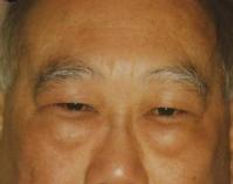
Asian Upper Eye Lid CO2 Laser Blepharoplasty

Before

After

Female 49 - Before

What is Asian eyelid surgery?
Asian blepharoplasty refers to procedures that are used on Asian eyelids, usually to create an eyelid crease or fold. Most procedures are performed in an outpatient surgery center under twilight-sleep anesthesia using laser techniques.
Who should consider Asian eyelid surgery?
Asian eyelid surgery is for persons who wish to alter, improve, or correct some aspects of their Asian eyelids.
Will I experience any discomfort during the treatment?
Female 49 - After
Procedures are performed under “twilight-sleep” anesthesia and you should experience no discomfort or anxiety during the procedures.

Female 57 - Before

Female 57 - After
How expensive is Asian eyelid surgery?
Both upper eyelids $6,650
Both lower eyelids $5,950
Upper and lower eyelids together $11,850
Price includes surgeon’s fee, anesthesia, and surgery center charges.
Consultation fees are separate ($95.00)


Male - Before
Male - After
Will insurance cover the cost of upper eyelid surgery?
Asian eyelid surgery is almost always cosmetic and the cost is $6650 for two upper eyelids. Insurance will cover upper eyelid surgery if: (1) you notice the eyelids blocking your vision, and (2) this shows on a photograph, and (3) your lids show enough loss of vision on a visual field testing, and (4) The visual fields and photos meet your insurance company's specific criteria. We will submit this information to your insurance company for predetermination if we feel you meet reasonable criteria. During your consultation, Dr. Khan can determine whether or not it is worthwhile obtaining testing for insurance coverage. Insurance will not cover puffy or wrinkled lower eyelids.


Ptosis - Before Repair
Ptosis - After Repair
Can any eyelid surgeon perform Asian eyelid surgery?
There are several important differences between traditional and Asian blepharoplasty to keep in mind. Foremost, one must determine the patient's goals regarding the height and contour of the final upper eyelid fold and it's relation to the eyelid margin. Some patients may desire a high "westernized" lid fold, whereas others seek to maintain their native lid fold and only wish to have it repositioned to a slightly higher and more youthful position ("rejuvenated"). The surgical procedure varies dramatically between these two patient groups and each will be discussed separately. Failure to individualize the operation to the patient's desires is a common and preventable error, represents a cultural ignorance on the part of the surgeon, and produces dissatisfied patients shopping for a surgeon who will give them back "their own eyelids".
In the Asian patient seeking "westernization" one must explain to the patient that the debulked higher "western" superior sulcus and upper eyelid fold must flow naturally out of any pre-existing medial canthal webbing or nasal eyelid folds. Otherwise, there will be an abrupt and unnatural transition from the flat low medial canthus to a high arched central eyelid. This limitation can be overcome with appropriate W-plasty procedures to address medial canthal webbing and folding. However, such techniques create visible incisions in the medial canthal region and are best avoided.
The "westernization" procedure is based upon removing the inferior pretarsal extent of the upper eyelid fat pads. This allows one to directly suture the inferior aspect of the blepharoplasty incision to the surface of the levator aponeurosis in order to create a new higher lid crease. Further removal of skin, muscle, eyelid fat and ROOF fat is exquisitely tailored in order to create a natural transition from the medial canthal structures and to avoid creating too radical a change in eyelid appearance.
The "rejuvenation" procedure is performed upon patients who wish to maintain their native Asian eyelid fold and crease but wish the fold to be raised to a more youthful height in order to re-expose a youthful band of pretarsal skin. The first thing to determine in these patients is the exact height of the desired new eyelid fold. This is determined by lifting the existing fold until the patient confirms the intended height. This distance from the lash line to the lid fold is measured in millimeters, sketched, and recorded in the chart. Second: since the new lid fold must flow naturally from the pre-existing medial eyelid fold. This is explained and demonstrated to the patient in front of a mirror. Third: determine and document the patient's expectations as to whether the lateral aspect of the eyelid fold parallels the eyelid margin, curves down towards the eyelid margin, or curves up and away from the eyelid margin. Each of these curves connotes a specific ethnic association among Asian cultures. The blepharoplasty incision in the rejuvenation procedure should be placed at the pre-existing lid crease. The only exception is when the desired final lid fold height is higher than the existing crease. Finally, the aging process in the Asian eyelid may create a mild fat pad herniation. One should determine if the patient desires fat pad removal. Removal of fat during the "rejuvenation" procedure should be extremely conservative to avoid creating a disastrous and unsightly hollowed superior sulcus coupled with a low skin fold. Be cognizant of an occasional lateral upper eyelid fat pad in some Asian ethnic subtypes. Finally, perfect symmetry is more important in Asian eyelids than in "western" eyelids. Hence, meticulous measurement of lid fold height and excised skin is prudent.
